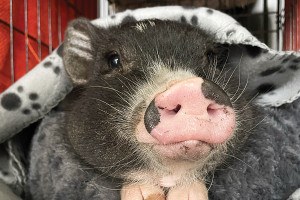Taste: Ingredients: The Last Saffron Farmer
On a damp Sunday afternoon in October, Robert Martin Keen drove down a craggy road in Landisville, Lancaster County. He parked in front of his weathered red barn and walked past vines that until a recent harvest held 22 tons of seyval and vidal grapes. And as the wind howled around the looming pecan and wild cherry trees, Keen stopped at a barren half-acre patch and muttered, “Usually by now, you start to see something coming through.”
Keen was looking for saffron. The world’s most expensive spice — sometimes $2,000 per pound — would seem to be the thing-that-doesn’t-belong-here. Lancaster County is, after all, known for decidedly lowbrow culinary contributions: shoofly pie, chowchow, scrapple. But while this revered herb, known to most as a quintessential paella and bouillabaisse ingredient, is usually associated with Iran and Spain — the former claiming most of the world’s production, the latter much of its consumption — saffron has been grown in area gardens since settlers first arrived from Germany, where it’s still an important spice.
Keen’s family began farming this land — now eight acres, down from what was once 350 — in 1725, growing everything from wheat to corn to tobacco. He was the first one, as far as he knows, to plant saffron here. He began what he calls his “brutal experiment” 20 years ago, in hopes of finding a cash crop when his grapevines started to falter. For many years, the experiment was a surprising success. When the New York Times conducted a taste test of saffron, it included Keen’s among Spanish and Iranian varieties. The Spanish saffron fell flat, but “Mr. Keen’s was terrific, as intense as the Persian,” the paper said. In a 2001 tasting in Cook’s Illustrated, an obsessively particular culinary magazine, the testers found the dish made with Keen’s bitter yet rich saffron to be “the overwhelming favorite.” None of this surprised Keen, who says, “I know we can grow an exceptional product here, certainly as good as those Iranians.”
While Keen is the only commercial saffron farmer in the area — in the country, no less — the herb is common in Pennsylvania Dutch kitchens and gardens. Local cooks put it in everything from boiled potatoes and egg noodles to stuffed pig stomach. “At Thanksgiving tables, you can’t have filling” — a.k.a. stuffing — “without it,” says Keen.
Normally, the first signs of the crop show up on his half-acre plot of dirt around mid-September. Grass-like leaves from the perennial corm Crocus sativus push through, heralding the appearance, about a month later, of dark purple flowers containing three deep-red stigma — the saffron threads. Once they bloom, the flowers must be picked within two days. If a hard rain or heavy frost doesn’t destroy the flowers and their contents before Keen gets to them, the rabbits will. So Keen crouches down, for seven hours at a time, pinching the flowers off by hand. “It’s tough on the body,” notes Keen, 53. “Eventually, your back just gets stuck.” As the picked flowers pile up, Keen’s workers begin the tedious operation of removing the stigma, also by hand. The picking and separating can take upwards of three weeks.
Once removed from the flower, the threads must be cured. “If you use it right away, it doesn’t have that smell. And people want that smell, believe me,” says Keen, adding that the scent, which has been compared to honey and sea air, is actually a product of the flavor’s breakdown. “You’ve got to find a balance between flavor and aroma, or people think it’s not saffron. It’s not really ready for about six months. So I won’t be selling this crop until June — assuming I have a good harvest.”
At its best, the plot produces 15 pounds of threads out of about 225,000 flowers. But after the weight loss that occurs during the six-month cure, 15 pounds become three. At $3 per half gram — the price Keen’s saffron gets in local shops — the street value of such a batch is just over $8,000. But it’s been a few years since Keen had a good harvest.
Of course, there’s plenty of fake saffron around, diluting the market and depressing prices. Most of the impostors derive from the safflower plant, which has nothing to do with saffron. The color they impart to a dish is similar, but the taste is nothing like the real thing. “I’ve seen ‘saffron’ on eBay for $1 an ounce,” says Keen. “There are even companies selling turmeric as powdered saffron.”
With all these hurdles, it’s not hard to understand why Keen is the only guy in the country trying to make a living out of saffron farming. What is hard to understand is why he puts himself through this profitless venture year after year, especially since his grape sales have taken off. It’s just a strange hobby, not unlike someone who risks painful stings to make his own honey. Keen simply says, “I guess I like a challenge.”
By November, when the saffron threads would normally be curing, there’s still not much coming out of the ground. “We have a couple of things popping up, but it doesn’t look good,” says Keen. Heavy frost is in the forecast, and downpours have been tearing up the ground in recent weeks. “These plants do what they want, when they want to. There’s no fixed schedule, no textbook scenario. So we’ll just have to wait and see what happens,” Keen says. “Even if I get nothing this year, I’ll be back up on this hill next year, standing here, just waiting.”
E-mail: vfiorillo@phillymag.com.


